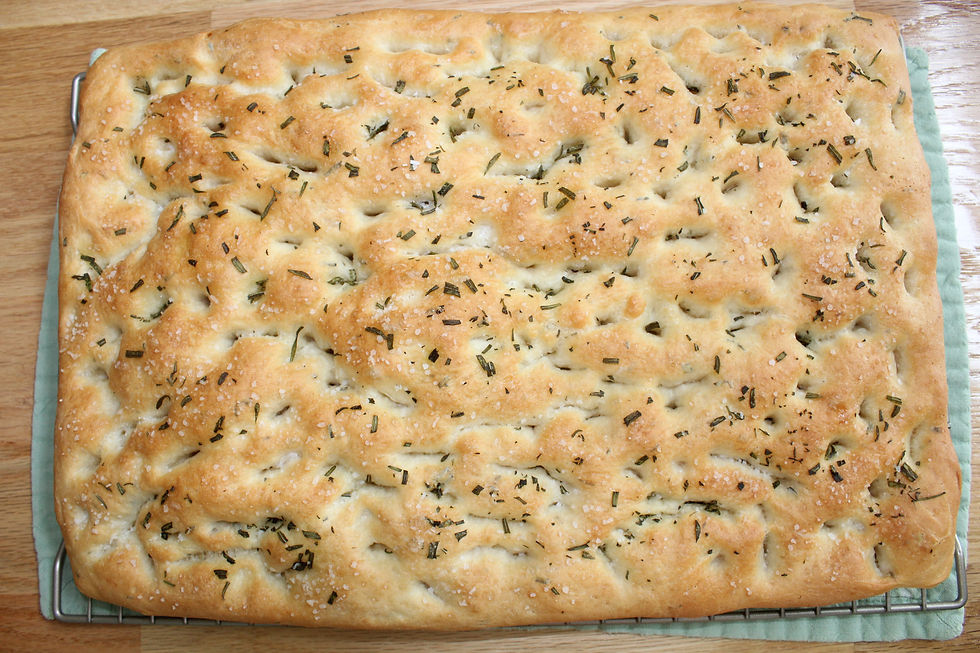Sourdough Country Bread
- Fanny Khan

- May 25, 2021
- 3 min read
Updated: Mar 10, 2023

Ingredients:
For the Levain:
40g (1 1/2 ounces/3 tbsp) warm water (90°F to 100°F)
30g (1 1/2 ounce/3tbsp) mature sourdough starter
40g (about 1 1/4 ounces/1/3 cup) bread flour
For the Dough:
473g (16 ounces/2 cups) warm water, divided
Levain (see above)
600g (21 ounces/ 4 cups) bread flour, plus more for work surface
1 tablespoon (1/4 ounce/9g) kosher salt
Wheat germ or white rice flour, for dusting
Using your fingers, in a large bowl, mix the water and sourdough starter until mostly dissolved. Mix in bread flour until no dry flour remains. Cover bowl with plastic wrap, let sit at room temperature for 12 hours.
Add 415g of warm water to the levain. Stir or mix with your fingers until dispersed. Add bread flour and mix until no dry flour remains. Cover with plastic wrap and let sit at room temperature for 30 minutes.
Uncover bowl and sprinkle dough with salt; add half of the remaining warm water. Use your fingers in a grabbing/squeezing motion to incorporate salt and water into the dough until mostly smooth; about 2 to 4 minutes. If dough seems too dry, add the remaining water. Cover with plastic wrap and let rest at room temperature until dough slightly increases in volume, 3 to 4 hours; stretching and folding dough back over itself every 30 minutes. This will make the dough strong and elastic.
Lightly dust top of dough with flour, turn dough out, floured side down, on work surface. Divide the dough into 2 portions.
Working with 1 piece of dough at a time, use a bench scraper or your palms, pull the dough towards you across work surface rotating about 90° as you drag it to develop tension and form a taut ball. Drag and rotate 4 times. Cover loosely with plastic wrap and let rest 30 minutes.
Repeat the above process (Step 5) with the 2nd piece of dough.
Generously dust 2 7- or 8-inch banneton with wheat germ or white rice flour or with a mix of wheat germ and white flour.
Using a bench scraper or your hands, gently lift the dough and carefully invert into the banneton or bowl (the seam side should be facing up).
At this point, if you are not baking, the dough can be covered and chilled in the proofing basket in the refrigerator for 8 and up to 24 hours to develop more flavor.
If you are not doing the refrigerated proofing, cover the dough lightly with plastic wrap and let rise at room temperature for 2 1/2 to 4 hours (depending on the temperature).
Place a pizza stone on the middle rack of the oven. Place 2 disposable pie plates half filled with lava rocks on the bottom of the oven. Preheat oven to 450° (425° convection) for 1 hour before baking bread. If the dough was refrigerated it does not need to come to room temperature before baking.
Keep 1 cup of boiling water handy.
Lightly dust surface of dough with wheat germ or white rice flour. Cut an 11-inch square piece of parchment paper. Place parchment over banneton and invert dough onto parchment, smooth side of dough should be on top. Using a bread lame or a very sharp knife, score a 6-inch long, 1/3-inch-deep slash down center of loaf. (Or score in any design you would like: e.g. X, leaves, wheat stalk.)
Using a pizza peel, carefully "scoop" dough on parchment and place directly on the pizza stone. Immediately pour the boiling water in the two pie plates with lava rocks and close the oven. Be careful not to get burn with the steam.
Bake bread for 30 to 35 minutes or until golden brown and an instant read thermometer inserted in center of bread registers 200°F. Transfer bread to a cooling rack, discard parchment paper and let cool completely, about 3 hours, before cutting.
Yields: 2 loaves
Notes&Tips:
Baking Sourdough Bread requires a lot of time and patience. However, once you have a good starter you will end up with excellent bread. There is nothing as satisfying as baking your own bread. It never ceases to amaze me that I have a produced a loaf that others enjoy and can never seem to get enough of.
If you do not have sourdough starter, you could purchase it from some reputable sites online. However, if you want the challenge of culturing your own, here's a link to guide you on cultivating your own sourdough starter: https://breadtopia.com/make-your-own-sourdough-starter/.
My kitchen is always cooler in the colder months and so I tend to give my bread dough the full time to let it proof. In the summer, though, I reduce the time as my kitchen is warmer. You can adjust your proofing time if you have a warmer environment or if you're baking in the warmer months.
I generally bake 1 bread at a time. However, if you have a large enough oven and 2 pizza stones, you could bake them at the same time.















Comments